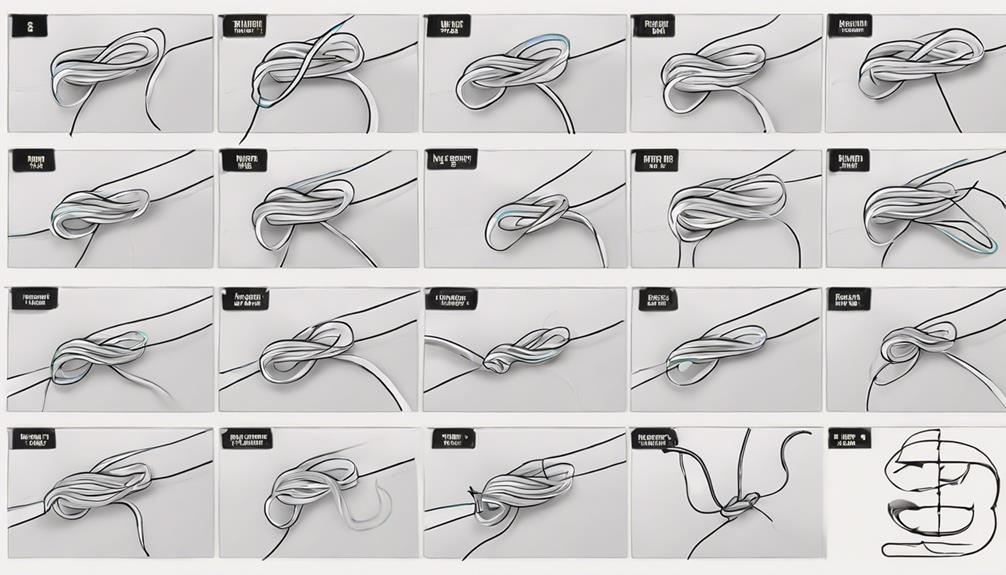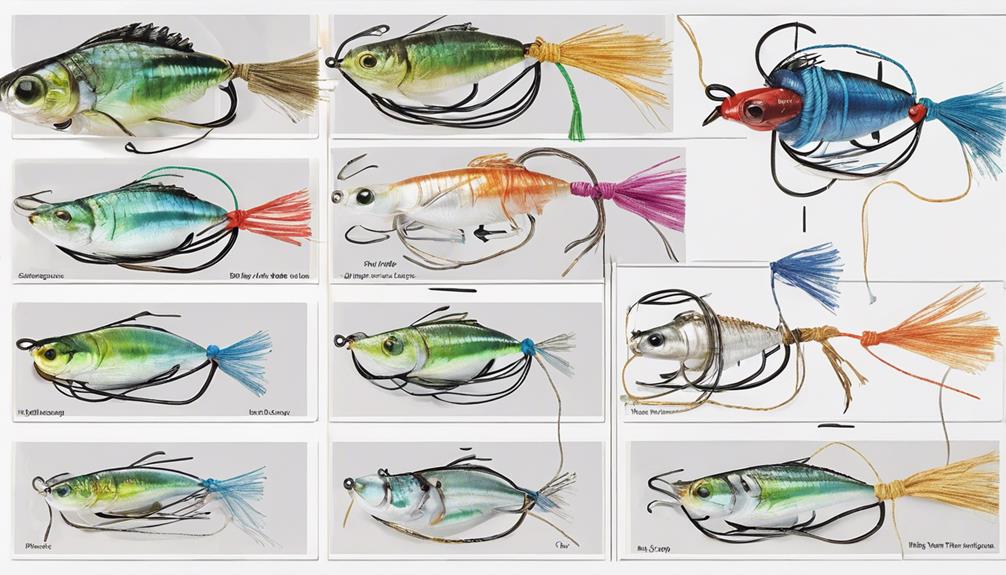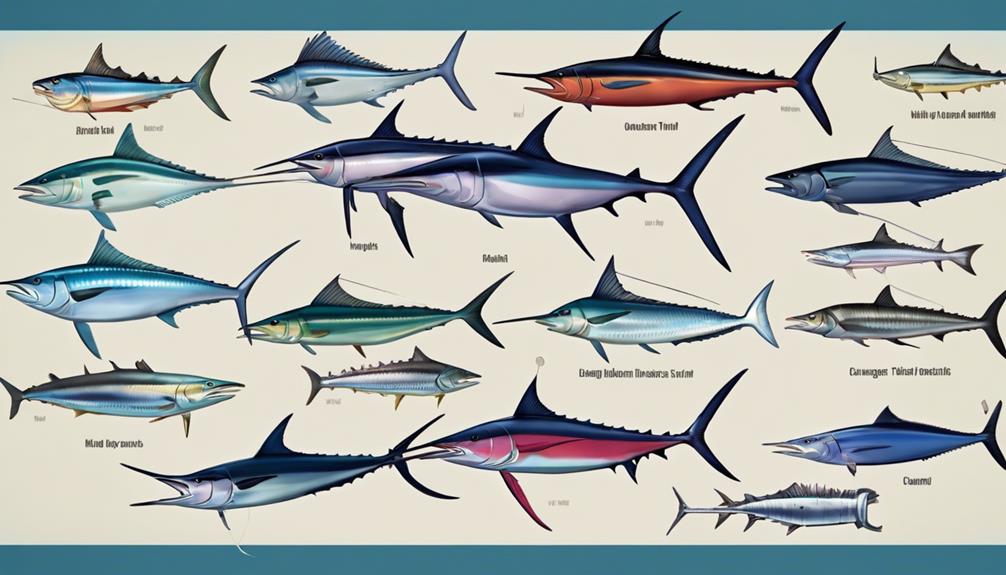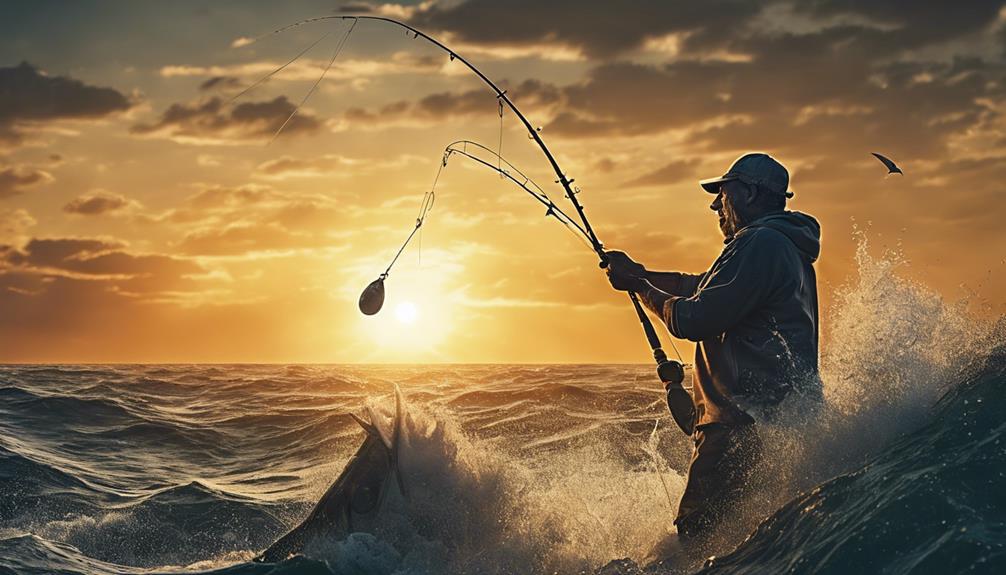When it comes to deep sea angling, mastering the art of tying the right knots is crucial for success. From the strength of the Palomar Knot to the versatility of the Improved Clinch Knot, each knot serves a specific purpose in your fishing endeavors.
However, what truly sets apart the best fishing knots for deep sea angling is their ability to withstand the unpredictable forces of the open ocean. Understanding which knots can handle the immense pressure and sudden movements of deep-sea catches will significantly impact your angling experience.
Palomar Knot
To tie the Palomar Knot for deep sea angling, gather the end of the line and double it to form a loop. The Palomar Knot is renowned for its exceptional knot strength and Palomar versatility, making it a favorite among anglers for various deep sea applications. This knot is particularly useful when targeting larger game fish that exert significant force on the line.
To proceed with the Palomar tying technique, pass the loop through the eye of the hook and then tie a simple overhand knot. Ensure the loop is large enough to pass the hook through. Next, take the hook and pass it through the loop created above the overhand knot. Before pulling the knot tight, wet it with some water or saliva to reduce friction and ensure a secure hold.
The Palomar Knot excels in maintaining its strength even with monofilament or braided lines, offering anglers confidence when battling powerful oceanic species. Its simplicity and effectiveness have solidified its reputation as a go-to knot for deep sea fishing endeavors.
Practice tying the Palomar Knot before your next deep sea angling trip to master this essential technique. With its proven track record in securing catches and withstanding intense fights, the Palomar Knot is a valuable addition to any angler's repertoire.
Improved Clinch Knot
For mastering the technique of tying the Improved Clinch Knot effectively, ensure you have a clear understanding of the steps involved. This knot is widely used in fishing due to its reliability and strength. When tied correctly, the Improved Clinch Knot provides excellent knot strength, making it a go-to choice for securing your hook or lure to the fishing line.
To tie the Improved Clinch Knot, start by threading the line through the eye of the hook and then double back parallel to the standing line. Create five to seven turns around the line before inserting the tag end through the loop closest to the eye of the hook. Moisten the knot before tightening it by pulling both the tag end and the standing line simultaneously. Trim any excess tag end to complete the knot tying process.
When it comes to knot tying techniques, practice is key. Ensuring each turn is neat and tight will enhance the knot's strength and reliability. Remember to trim any excess line after tightening the knot to prevent interference with your fishing experience. With a solid grasp of the Improved Clinch Knot and its tying techniques, you can feel confident in your deep-sea angling adventures.
Bimini Twist
When mastering the Bimini Twist knot for deep sea angling, ensure your line is taught and free from any tangles. The Bimini Twist is known for its exceptional strength, making it a reliable choice for deep sea fishing. To tie this knot effectively, double about 5 feet of line back on itself, then twist it 20-30 times to form the initial twists. Create a loop and wrap the twisted section around the loop's base, securing it with several wraps. Finally, tighten the knot by pulling both ends of the line and the loop simultaneously.
The Bimini Twist knot's strength is one of its main advantages for deep sea fishing. This knot retains nearly 100% of the line's original strength when tied correctly, providing anglers with confidence when battling large, powerful fish. Additionally, the Bimini Twist creates a double line in the leader, which distributes the pressure evenly when fighting fish, reducing the risk of line breakage.
Albright Knot
The Albright Knot is a reliable choice for connecting different types of fishing lines with varying diameters. This knot is highly favored for its ability to maintain line strength, making it ideal for saltwater applications where the strength of the connection is crucial.
When you're deep-sea angling and need to join a heavy monofilament or fluorocarbon leader to a lighter braided mainline, the Albright Knot is your go-to option.
To tie the Albright Knot, start by doubling back about 10 inches of the mainline and overlap it with the leader line. Then, make ten wraps with the mainline around both lines and thread it through the loop between the lines and the leader. After moistening the knot, pull the mainline to tighten the wraps and trim off the tag end to complete the knot. The Albright Knot's design ensures that the connection point maintains a high percentage of the line strength, which is crucial when battling large saltwater game fish.
In saltwater applications, where the fish are powerful and can put immense pressure on the line, having a secure knot like the Albright is essential. Practice tying this knot beforehand so that you can quickly and confidently rig your lines when out on the water.
Double Uni Knot
To secure a strong and reliable connection between two lines of similar or different diameters, consider mastering the Double Uni Knot. This knot is highly effective for joining lines when fishing deep sea waters.
Some key points about the Double Uni Knot include:
- Knot strength: The Double Uni Knot is known for its exceptional strength, making it a reliable choice when dealing with large, hard-fighting fish in deep sea angling.
- Compatibility: This knot is versatile and can be used to connect lines of different materials or diameters with ease, providing anglers with flexibility in their setups.
- Knot tying techniques: Mastering the Double Uni Knot may take some practice, but once perfected, it becomes a valuable skill in your fishing repertoire.
- Variations: While the basic Double Uni Knot is effective on its own, there are variations and enhancements that anglers can explore to suit their specific fishing needs or preferences.
San Diego Jam Knot
Consider mastering the effective San Diego Jam Knot for securing your line when deep sea angling. This knot is known for its exceptional knot strength, making it a reliable choice when dealing with big game fish in deep waters. The San Diego Jam Knot is particularly popular among anglers for its simplicity and efficiency in securing hooks, swivels, and artificial lures to the fishing line.
To tie the San Diego Jam Knot, start by running the tag end of the line through the eye of the hook and doubling it back. Then, make five to seven wraps around the doubled line. After completing the wraps, thread the tag end back through the gap formed near the eye of the hook. Moisten the knot before pulling the tag end to tighten it securely against the eye of the hook. Trim any excess line to finish the knot.
When it comes to knot tying techniques, the key to a strong San Diego Jam Knot lies in ensuring that the wraps are snug and compact. This knot is reliable for both monofilament and braided lines, providing anglers with a versatile option for various fishing scenarios. With its straightforward tying process and impressive knot strength, the San Diego Jam Knot is a valuable addition to any angler's repertoire for deep sea angling.
FG Knot

Want to enhance your deep sea angling skills with a knot known for its strength and reliability? The FG knot is a popular choice among anglers for its exceptional durability and resistance to abrasion, making it ideal for tackling large and powerful fish in deep sea fishing scenarios.
Advantages of the FG Knot:
- Exceptional Strength: The FG knot is renowned for its incredible strength, allowing you to confidently battle against hard-fighting fish without worrying about your line snapping.
- Low Profile: This knot has a sleek and low-profile design, reducing the chances of snagging on guides or causing any interference during casting or retrieving.
- Abrasion Resistance: With its intricate wrapping technique, the FG knot provides excellent resistance to abrasion, ensuring that your line remains intact even in rough conditions.
- Smooth Casting: The smooth profile of the FG knot helps in maintaining the line's casting ability, allowing for longer and more accurate casts when targeting deep sea species.
Best Applications for FG Knot in Deep Sea Fishing:
- Attaching Braided Line to Leader: The FG knot excels in connecting a braided mainline to a fluorocarbon or monofilament leader, providing a secure and reliable connection.
- Big Game Fishing: When targeting large game fish such as tuna, marlin, or sailfish, the FG knot's strength and durability make it a preferred choice for handling the intense battles that ensue.
- Jigging and Popping: For vertical jigging or topwater popping techniques, where a strong and reliable connection is crucial, the FG knot ensures that your gear holds up under pressure.
- Bottom Fishing: When bottom fishing in deep waters where sharp structures are present, the abrasion resistance of the FG knot helps in preventing line breakages and lost catches.
Loop-to-Loop Connection
Enhance your deep sea angling skills by mastering the Loop-to-Loop Connection, a versatile knot technique that offers convenience and efficiency when rigging your tackle. This method is particularly useful in saltwater applications for leader connections due to its strong loop strength and straightforward tying technique.
When it comes to loop strength, the Loop-to-Loop Connection excels, providing a reliable link between your mainline and leader. The key lies in ensuring that both loops are formed correctly and snugly interlocked to prevent slippage under pressure. This knot's robust design helps maintain the integrity of your line setup even when battling large, powerful oceanic species.
Mastering the tying technique for the Loop-to-Loop Connection is essential for seamless execution. Begin by forming a loop at the end of your mainline and passing it through the leader loop. Then, bring the mainline loop over the leader loop and pull it through, creating a secure connection. Practice this process until you can tie it efficiently, even in challenging weather conditions or low light situations.
Whether you're targeting trophy fish or enjoying a leisurely day on the water, the Loop-to-Loop Connection offers a quick and reliable solution for joining your mainline to a leader. By understanding its strengths and mastering the tying technique, you can enhance your deep sea angling experience with confidence and ease.
Frequently Asked Questions
What Are Some Common Mistakes to Avoid When Tying Fishing Knots for Deep Sea Angling?
When tying fishing knots for deep sea angling, common mistakes can ruin your chances of a successful catch. Proper technique is key to avoiding these errors.
Always ensure you're using the correct knot for the specific type of line and hook you're working with. Take your time and double-check each step to prevent any weak spots in the knot that could lead to breakage.
Mastering the right technique will improve your chances of landing that big fish.
How Do Different Fishing Knot Materials, Such as Monofilament and Braided Line, Affect the Strength and Performance of the Knot?
When you're considering how different fishing knot materials like monofilament and braided line affect the knot's strength and performance, think about knot lubrication and durability. Different materials may require specific knot tying techniques and tension for optimal results.
Monofilament can be slick and may benefit from extra lubrication, while braided line tends to be more durable. Understanding these differences can help you tie stronger knots for successful deep sea angling.
Are There Any Specific Conditions or Types of Fishing Where One Knot May Be More Advantageous Than Another?
When deciding on the best fishing knot for your needs, consider the specific conditions you'll be facing. Certain knots excel in different situations, such as high knot strength or exceptional durability.
Knowing the right knot tying techniques and tips can make a significant difference in your fishing success. By understanding the advantages of each knot type, you can enhance your fishing experience and increase your chances of reeling in a big catch.
Can the Same Knot Be Used for Tying Leaders and Connecting Lines When Deep Sea Angling?
When deep sea angling, using the same knot for tying leaders and connecting lines can be beneficial. It ensures consistent leader strength and secure line connections.
Mastering knot tying techniques is crucial for successful fishing trips.
Regularly checking and maintaining your fishing gear will help prevent knots from slipping or breaking, ultimately leading to a more productive and enjoyable angling experience.
How Important Is It to Regularly Check and Maintain the Integrity of Fishing Knots During a Deep Sea Fishing Trip?
Regularly checking and maintaining the integrity of your fishing knots during a deep sea fishing trip is crucial.
Knot durability and tension are key for preventing breakages. Ensure knot lubrication and security by inspecting for any signs of wear or weakness.
Taking a few moments to double-check your knots can make a big difference in landing that big catch.
Conclusion
Now that you know these 4 best fishing knots for deep sea angling, you'll be well-equipped to handle any situation out on the water.
Practice tying them before your next fishing trip so you can quickly and confidently secure your line.
Remember, the right knot can make all the difference in landing that big catch.
Happy fishing!



